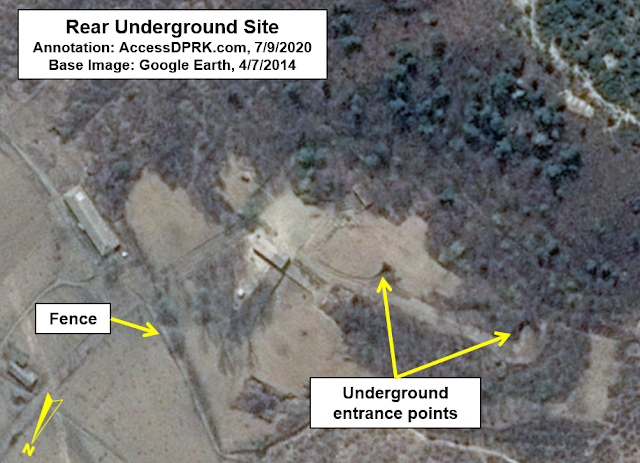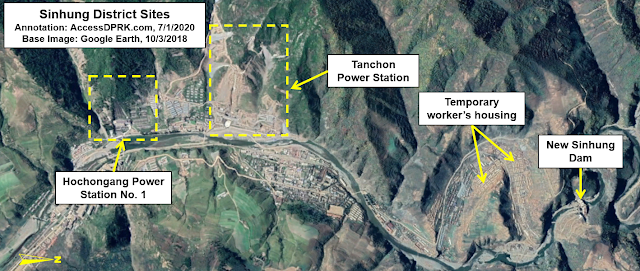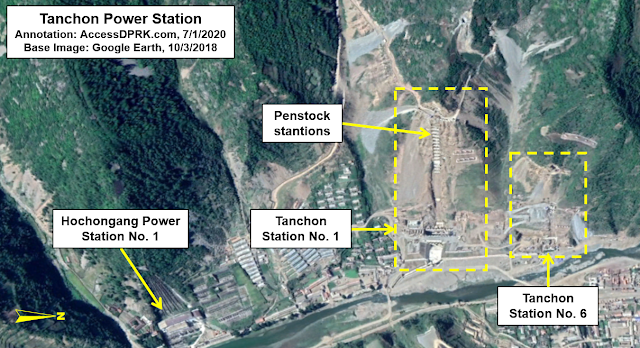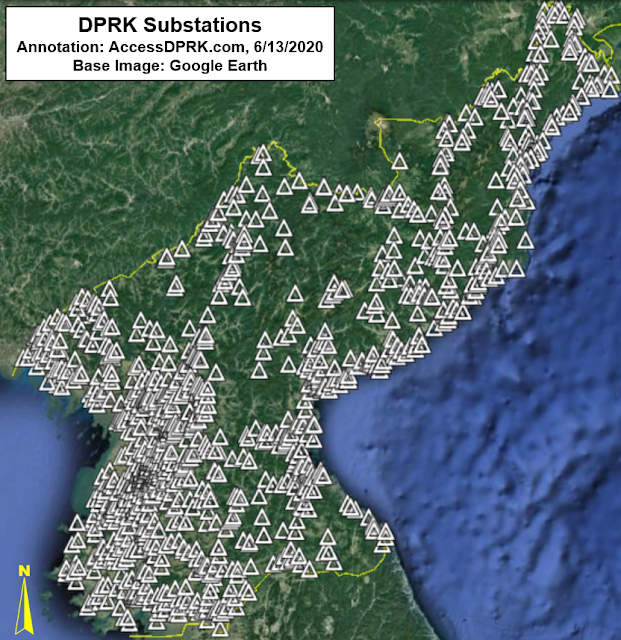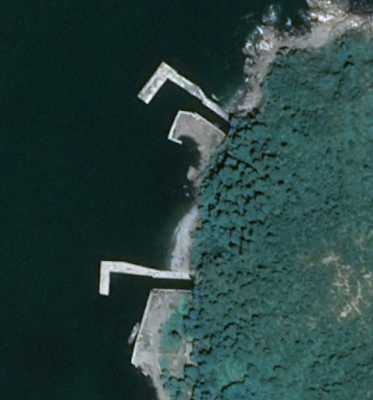Many countries have underground facilities for their navies. Places to protect submarines, places to defend against surprise or nuclear attacks, underground storage, places that have all kinds of purposes.
One large example was the
Soviet base in Balaklava, Crimea. China currently maintains at least
six underground submarine bases. The
United States has an enormous underground fuel storage site in Hawaii.
North Korea is no different.
North Korea has a tremendous amount of experience digging tunnels. I have found hundreds of tunnels across the country, hundreds of artillery sites that pop out of tunnels, scores of underground factories, and quite a few underground naval sites.
Bounded on two sides by the ocean and with 2,495 km of coastline, the Korean People's Navy has a strength of 60,000 men and over 800 vessels, making it one of the largest navies in the world in terms of vessel numbers. And while most of their naval technologies are decades behind the West, Kim Jong Un has been focusing on
modernizing the fleet. Furthermore, what they lack in technology they can make up (some of that gap) by sheer numbers.
North Korea has 70-80 submarines, which places them on par with the United States (based on numbers) and far outpaces South Korea. Their navy has been able to inflict substantial damage in attacks like the
Second Battle of Yeonpyeong in 2002.
And so, it makes sense to marry navy and tunnel together. Underground naval bases provide safety in the event of attack and secrecy to develop, arm, refuel, and launch attacks. Having multiple sites also makes it more difficult for an attacking country to quickly knock out North Korea's navy.
The country has 13 identified underground naval sites. Some can accommodate submarines but most currently serve various types of surface ships. Interestingly, North Korea's main submarine base for the Sea of Japan (East Sea), which is based on Mayang Island, lacks any apparent underground facilities.
(Click on images for larger view)
The facilities range from simple tunnels to more complex facilities that are accessed from the sea and cover a large footprint.
Starting with the Yellow Sea (West Sea) bases:
Taewha-do Underground Base: 39°25'59.69"N 124°37'2.39"E
Taewha-do is on an island (the -do suffix means island) and consists of a small underground facility and a turntable to enable vessels to be moved around the base on a short rail system. There is only a single dual entrance/exit point to the underground facility (UGF) but the island's size could theoretically accommodate an enormous UGF inside. However, it only appears to house small patrol boats and the island garrison is no larger than battalion sized.
Very little information about the base is publicly available and most of the information that does exist relates to a series of small military actions during the Korean War, before the UGF was construction. The island rises steeply out of the ocean and can provide up to 600 feet of solid rock on top of the UGF, giving it excellent protection.
Sok-do is not necessarily an underground base but rather it is a set of four hardened pens that allow craft to be protected. Located at 38°38'7.33"N 125° 0'26.27"E, it doesn't appear to be in use. It lies just 5 km from Pip'a-got, which is a primary naval base.
Pip'a-got is the largest naval base immediately outside of the West Sea Barrage, which cuts off direct access to the Taedong River and Pyongyang.
Pip'a-got naval base.
The base consists of a large protected harbor (created by a set of breakwaters), hundreds of buildings, and seven distinct ship handling sites (dry docks, main harbor, UGF, etc). It covers approx. 5 square kilometers.
The underground component consists of a 600-meter long tunnel that connects a turntable (that can take ships from a slip and bring them to the tunnel entrance) to an exit that enters directly into the sea, bypassing the large seawalls.
The tunnel could include other facilities like fueling, loading weapons, and repair, but the interior layout is not known. The hill it cuts beneath rises from ~90 feet at the turntable to a maximum height of ~250 feet along the path of the tunnel.
Sunwi-do & Sagot (Ryongho) Bases
Sunwi-do has a small base at the far northeast end of the island. It is across from the larger Sagot base on Ryongho Island 4 km to the north. Both bases are in South Hwanghae Province are the southernmost underground naval facilities on the west coast. The base at Sunwi-do lies a 31 km from the South Korean island of Yeongpyeong.
The base on Sunwi Island, 37°46'11.59"N 125°20'21.45"E
At its height, the island provides ~180 feet of rock over the Sunwi tunnel which runs for 250 meters.
North Korea has several classes of patrol boats and Sunwi seems to be a base for them. In the imagery provided by Google Earth, at no time has there been more than 13 ships and none over ~28 meters in length.
In this image of Ryongho, four classes of ship can be seen. Upwards of 36 ships have been seen at Ryongho but some may have actually been small fishing vessels along with the military craft.
Sagot base is split between two main facilities. One is at the town of Sagot, on the mainland 1.8 km to the north, and the second is the UGF on Ryongho Island (37°48'17.24"N 125°21'9.58"E).
A direct line from the Ryongho entrance to the exit runs 290 meters but the full tunnel path isn't a straight line. It is likely at least 365 meters in total length. Between 150 and 250 feet of rock sits above the site, depending on location.
The exit has apparently silted up and cannot be used as a direct exit point for sailing into the sea. Any vessel must be towed down the "hump" from the UGF exit point to the water. Why this hasn't been corrected would only be speculation, but it has been the case since at least 2004.
NK-01 antiship cruise missiles (a local variant of the Soviet P-15
Termit (aka
Styx) are
believed to be deployed at the base.
Along the northeast edge of the island is a series of small tunnels for terrestrial vehicles and other equipment. This is a common feature found at many bases across the country.
East Sea (Sea of Japan) Bases
Puam-dong is the first base on the east coast. (Going north to south, as I did for the Yellow Sea bases.) Located at 41°19'17.15"N 129°46'4.71"E it is a primary navy base and has a large harbor protected by ~470 meters of breakwaters.
The base has been called a submarine base (and some of its features support that conclusion) but no submarines are visible in the available imagery. Other vessels stationed at the base include the
Sohung-class PTG (guided missile patrol boat). This has been a
key base for them since at least the 1980s.
Puam-dong is divided into two sections because of a hill in the middle of the base. The main section has headquarter facilities, barracks, and other buildings. The second section (to the south) is for maintenance.
The tunnel runs for at least 425 meters and the hill provides ~270 feet of rock above. The base also has a small underground storage facility higher in the hills at 41°20'12.02"N 129°45'24.94"E.
Cha'ho is a major submarine base located at 40°12'18.28"N 128°38'59.31"E in S. Hamgyong province. Including the harbor, it covers approx. 7.7 square kilometers.
Development of Cha-ho began in 1961 and it was transformed from a small base for patrol craft to a major submarine facility. By
1968 the underground portion was under construction. Unlike many other bases, it has rail access.
Unlike land-based underground facilities, where large piles of debris can be seen and analyzed to yield the approximate volume of the UGF, sea-based sites tend to lack any visible debris (since it can just be dumped under water) making it almost impossible to determine its size or layout using traditional methods. (Technology does exist that can shed light on the internal nature of the site using special techniques, but those are beyond the reach of most.)
However, at least a portion of the quay positioned between the entrances of the UGF may be made up of excavated debris based on a review of declassified images.
Taking the curved shape into account, the tunnel runs at least 330 meters and is protected by upwards of 200 feet of rock. I suspect that the main tunnel is placed farther back than I have it drawn, but that's why things are labeled "approximate".
Throughout the base Sang-O class (mini subs) and Romeo-class submarines can be seen. Romeo's are Chinese built, Soviet originated submarines that North Korea first acquired in 1973.
Ryoho-ri (Toejo-dong) Base is the location of the East Sea Fleet Command. It goes by several designations, Ryoho-ri, Yŏho-ri (an alternate spelling), and Toejo-dong (the name of the bay and also commonly used). Its location is 39°52'33.92"N 127°46'43.45"E.
As if signifying the base's importance, one of North Korea's many leadership residences is adjacent to the base. Ryoho is also serviced by rail.
The base doesn't appear to have any shipbuilding capabilities, but it does have a small repair facility for patrol boats. As mentioned, it is the headquarters for the East Sea Fleet and commands all of the bases and associated facilities along the east coast. One of the subordinate units at the base is KPA Unit 158.
The underground facility follows the same basic design as all the others. Its tunnel is ~315 meters long and is covered by roughly 200 feet of rock.
Samil-ri is a small UGF that consists of a single entry point. Located at 39°22'18.03"N 127°26'18.43"E it is on a small peninsula that's part of the much larger Munchon Naval Base.
Across from it on the other side of the peninsula (over 900 meters away) is a turntable but it doesn't appear to have been used in years and the images available on Google Earth make it difficult to confidently assert that there's a tunnel connecting the two points.
It's hard to gauge how active this site is, particularly since the turntable doesn't appear to be in use, but the wider Munchon area has been the
focus of a large modernization and expansion program which has been ongoing since 2014. The Munchon-Wonsan region is an important military and industrial area, and various improvement projects have occurred there including the
Kalma International Airport,
Wonsan-Kalma tourist zone, and the nearby
Hodo missile test facility.
Of note, various materials can be seen at the entrance site in recent images that could be used in a restoration project.
Sindo & Yodo island bases
Sindo is a small, narrow island in Yonghung Bay, off of Wonsan. It has a small underground site but unlike Samil-ri it definitely doesn't have an exit point. It is located at 39°13'18.11"N 127°31'10.04"E and would have a maximum length of 85 meters (based on the particulars of the island). The island's garrison seems to be geared toward operating coastal defense artillery and is located nearly a kilometer to the east.
The Yodo island site is located 8.7 km east of the Sindo site. Like Sindo, it doesn't have a second entry/exit point, but it does have a turntable. This allows approx. 8 vessels to sit on the beach and then individually brought into the tunnel for servicing and then moved back out and onto the "holding yard".
If you look closely at the image, you can see a vessel halfway in (or out) of the tunnel entrance.
Yodo has a much larger garrison and even has a small grass runway that extends for 660 meters (although a dirt path cuts across it near the southern end). The naval tunnel may run for 180 meters into the hill to reach 140-150 feet of rock depth. Directly across is a hardened coastal artillery battery and those tend to have small tunnels connecting them to the outside. If we assume the tunnel comes close to the battery, then the tunnel may run as much as 200-230 meters.
Namae Navy Base
Located at 38°48'9.76"N 128° 8'18.58"E Namae is a large navy base with a breakwater that creates 38 hectares of protected harbor. The northern end of the base contains the underground facility. Namae has the facilities available to service all of North Korea's surface fleet and may be able to dock submarines.
The entrance is approx. 20 meters in width and could be covered by as much as 200 feet of rock. There does appear to have been an exit point built, but the tunneling work was either never finished or there was some other problem. An exit structure was built but is in a state of disrepair.
By 2013 a hole had appeared in the roof of the
possible exit structure and by 2019 the roof had collapsed entirely. Had the entire facility been completed, the tunnel would have run 515 meters and would make it the second longest confirmed tunnel after Pip'a-got.
Possible exit structure with collapsed roof.
The last of North Korea's underground navy sites is at
Changjon, 38°43'59.96"N 128°12'45.45"E.
It's the southernmost naval facility on the east coast and lies a mere 18 km from the military demarcation line.
Changjon is divided into two sections. The northern section contains a large active navy base, the southern section (~1.8 km away) has the underground facility but it appears to have been abandoned. No military vessels can be seen in Google Earth images (which go back to 2005), and there is a civilian dock with a floating restaurant just a kilometer away. It's part of the Kumgang tourism system.
At the same time, a small naval unit is still directly connected to it and the base did serve as a
"frontline base for North Korean submarines" before being suspended as part of the creation of the aforementioned tourist zone. However, Kim Jong Un has recently expressed a desire to enlarge the base, so this portion of it may become active again in the future.
Additional reading:
Work on Major Hovercraft Base Advances, AccessDPRK, 1/17/2020
I would like to thank my current
Patreon supporters: Amanda O., GreatPoppo, Kbechs87, Planefag, Russ Johnson, and Travis Murdock.
--Jacob Bogle, 5/9/2020
AccessDPRK.com
JacobBogle.com
Facebook.com/accessdprk
Twitter.com/JacobBogle


